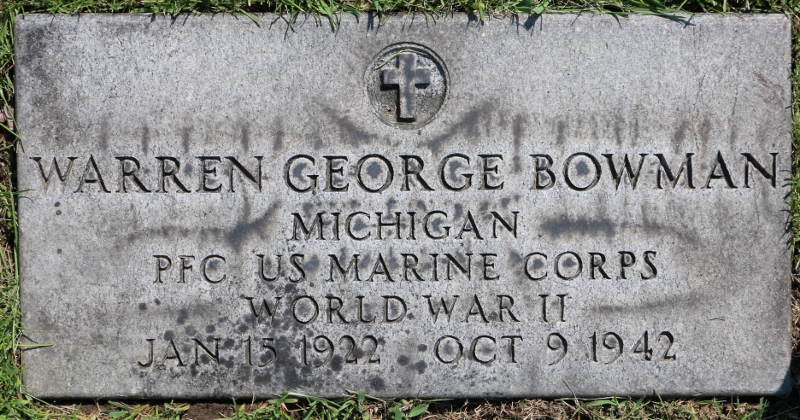PFC Warren G. Bowman KIA Solomon Is, October 9, 1942
Unit Company D, 1st Marine Raider Battalion, 1st Marines 1st Marine Division, FMF
Hometown: Detroit, Michigan
Father, Mr. Carl Bowman
service# 295797
Awards: World War II Victory Medal, Purple Heart
Details of career here.
Watchtower included Marine amphibious landings on the islands of Tulagi, Tanambogo-Gavutu, Florida, and Guadalcanal in the southern Solomon archipelago. Literally leading the way in the offensive was the 1st Marine Raider Battalion commanded by Lt. Col. Merritt "Red Mike" Edson.
Actions on 7-9 October
The destruction of the Japanese west of the Matanikau continued to be the ultimate objective of the Marines. An immediate objective, and one that could be attained while sufficient strength was building up for the final blow, was that of so disrupting enemy plans that his forces would be kept off balance and that he would not be able to launch a coordinated attack upon the perimeter. Operation Plan 2-4233 was issued in accordance with this train of thought. The force employed was to consist of something in excess of five rifle battalions--5th Marines (less 1st Battalion); 3d Battalion, 2d Marines (plus Scout-Sniper detachment); and 7th Marines (less 3d Battalion)--with strong and carefully coordinated artillery and air support. The operation was to be carried out directly under division control, and there was a reserve force of one battalion--3d Battalion, 1st Marines. The plan contained a hint that the latter unit would be used in a shore-to-shore movement, for there was provision for a boat group, and the reserve was ordered to be prepared to move out on 30 minutes' notice.
The plan for the attack followed roughly that for the unsuccessful affair which had preceded it. There was to be a force (5th Marines) along the east bank of the river for a distance of 1800 yards upstream from the mouth, while the main assault force's 3d Battalion, 2d Marines plus Scout-Snipers (called the "Whaling Group" form the name of the officer commanding the Scout-Snipers, Colonel William J. Whaling)34, and the 7th Marines, operating to the left of the 5th Marines would cross the river at the point of the unsuccessful attempt of the previous week and attack northward across the high ground to the south of Matanikau village with the village as the objective. The formation for this attack would consist of the Whaling Group advancing across the ridges with its right flank along the river, while the 7th, following across the river, would operate on its left, seizing the high ground to the southwest of Point Cruz and cutting off the retreat of the enemy. October 8th was designated as D-day.
October 7th saw the advance begun from the perimeter by the assigned groups.35 .
PFC Warren G. Bowman KIA Solomon Is, October 9, 1942
Unit Company D, 1st Marine Raider Battalion, 1st Marines 1st Marine Division, FMF
Hometown: Detroit, Michigan
Father, Mr. Carl Bowman
service# 295797
Awards: World War II Victory Medal, Purple Heart
Details of career here.
Watchtower included Marine amphibious landings on the islands of Tulagi, Tanambogo-Gavutu, Florida, and Guadalcanal in the southern Solomon archipelago. Literally leading the way in the offensive was the 1st Marine Raider Battalion commanded by Lt. Col. Merritt "Red Mike" Edson.
Actions on 7-9 October
The destruction of the Japanese west of the Matanikau continued to be the ultimate objective of the Marines. An immediate objective, and one that could be attained while sufficient strength was building up for the final blow, was that of so disrupting enemy plans that his forces would be kept off balance and that he would not be able to launch a coordinated attack upon the perimeter. Operation Plan 2-4233 was issued in accordance with this train of thought. The force employed was to consist of something in excess of five rifle battalions--5th Marines (less 1st Battalion); 3d Battalion, 2d Marines (plus Scout-Sniper detachment); and 7th Marines (less 3d Battalion)--with strong and carefully coordinated artillery and air support. The operation was to be carried out directly under division control, and there was a reserve force of one battalion--3d Battalion, 1st Marines. The plan contained a hint that the latter unit would be used in a shore-to-shore movement, for there was provision for a boat group, and the reserve was ordered to be prepared to move out on 30 minutes' notice.
The plan for the attack followed roughly that for the unsuccessful affair which had preceded it. There was to be a force (5th Marines) along the east bank of the river for a distance of 1800 yards upstream from the mouth, while the main assault force's 3d Battalion, 2d Marines plus Scout-Snipers (called the "Whaling Group" form the name of the officer commanding the Scout-Snipers, Colonel William J. Whaling)34, and the 7th Marines, operating to the left of the 5th Marines would cross the river at the point of the unsuccessful attempt of the previous week and attack northward across the high ground to the south of Matanikau village with the village as the objective. The formation for this attack would consist of the Whaling Group advancing across the ridges with its right flank along the river, while the 7th, following across the river, would operate on its left, seizing the high ground to the southwest of Point Cruz and cutting off the retreat of the enemy. October 8th was designated as D-day.
October 7th saw the advance begun from the perimeter by the assigned groups.35 .
Sponsored by Ancestry
Advertisement
Records on Ancestry
Sponsored by Ancestry
Advertisement






